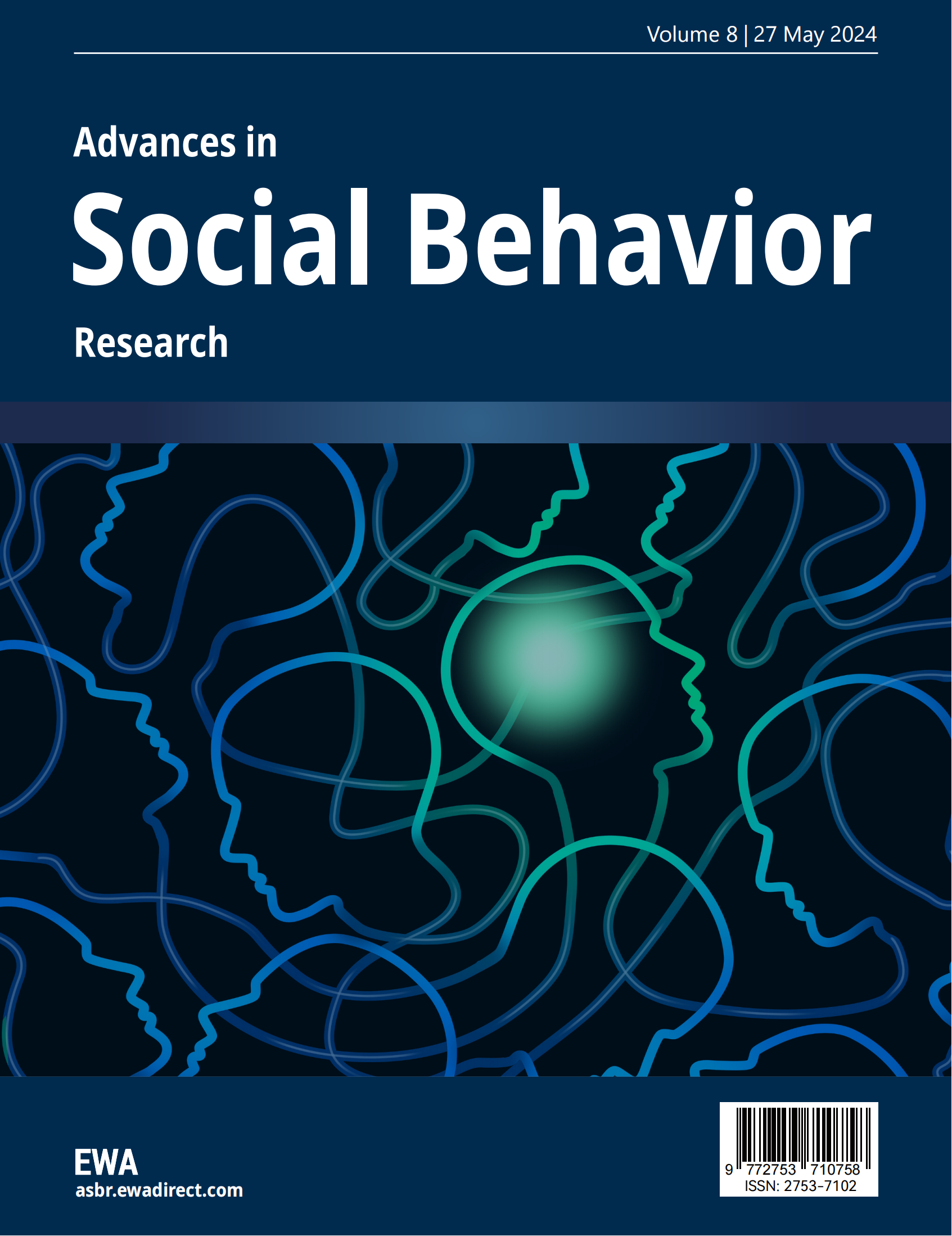1 Introduction
The report of the 20th National Congress of the Communist Party of China explicitly mandates the implementation of the fundamental task of “fostering virtue through education.” This national strategy also poses new high-quality development tasks for foreign language teaching in higher education institutions. Wu Yan [1] emphasizes that national higher education practitioners should focus on the “new infrastructure” of teaching, which includes the construction of disciplines, curriculum quality, textbook quality, and technological level. Higher education in foreign languages has entered a new normal of development characterized by keywords such as “new liberal arts, curriculum ideology and politics, and online teaching” [2]. This new normal requires the high-quality construction of foreign language courses. Lattuca & Stark [3] define a curriculum as an academic plan that encompasses various dimensions, including objectives, content, learners, teaching processes, teaching resources, and assessment.
In the process of constructing a first-class “Basic English” course, it is essential to clarify the concept of course design. Zhong Qiquan [4] argues that course design primarily includes four elements: course objectives, course content, learning activities, and evaluation methods. The teaching team analyzes the learning situation and tailors the teaching according to specific problems, explores ideological and political elements, integrates teaching resources, and utilizes a blended teaching method combining online and offline approaches. This creates a comprehensive classroom and conducts both formative and summative evaluations of students, ultimately improving teaching effectiveness.
2 Analysis of the Learning Situation and Identification of Key Issues
The “Basic English” course is a foundational course for Business English majors at our institution. It serves as a transitional course from high school English learning to autonomous college-level English learning. The course comprises 128 hours and 8 credits, spanning the first and second semesters. It focuses on developing students’ basic skills in listening, speaking, reading, writing, and translation, helping them build a solid foundation in the English language, and enhancing their cultural literacy and intercultural communication skills. The following key issues have been identified in previous teaching sessions:
1. Failure to Achieve Teaching Objectives as Expected: In previous teaching sessions, teachers primarily employed input-based teaching methods, which did not stimulate students’ learning enthusiasm and initiative. Students engaged in passive learning in the classroom, and their central role was overlooked. Consequently, the established teaching objectives were not achieved as expected.
2. Difficulty in Cultivating Higher-Order Abilities: Classroom activities designed by teachers focused on low-level knowledge such as vocabulary, grammar exercises, text analysis, and sentence translation. Two-thirds of the students had relatively weak listening and speaking abilities. Classroom teaching activities did not sufficiently enhance students’ basic skills, cultural awareness, and intercultural communication abilities.
3. Limited Teaching Resources with a “Textbook-Only” Approach: Teachers taught directly from the textbook, and the course content was limited to the textbook itself. The teaching methods relied on “PPT + blackboard writing,” and multimedia courseware was used only for textual displays. This approach failed to create an authentic language environment for students and did not establish a comprehensive teaching resource library that included textbook resources, online resources, and self-made content.
4. Insufficient Integration of Curriculum Ideology and Politics: Before innovation, the teaching content primarily revolved around basic forms of foreign cultures, with minimal content related to patriotism and moral education. This requires teachers to think about how to organically integrate ideological and political education elements into teaching, deeply explore and refine elements with “curriculum ideology and politics” functions, and achieve the goal of “holistic education.”
3 Targeted Design to Formulate an Innovative Teaching Plan
To address the aforementioned key issues, team members have continuously explored and experimented in their teaching practices. They have actively sought to overcome the limitations of traditional educational concepts, teaching resources, and teaching models. Adhering to a “student-centered” philosophy, the goal is to enhance students’ initiative and interest in learning, guiding them to independently explore new knowledge. This has led to the development of a blended teaching model that combines “physical classroom + online teaching platforms (DingTalk live broadcast + Rain Classroom) + student mobile terminals”:
3.1. Teaching Philosophy: Adhering to “Student-Centered and Outcome-Oriented” to Avoid “Input-Output Imbalance”
Guided by the educational philosophy of “student-centered and outcome-oriented,” the course aligns with the demands of the employment market by refining the talent cultivation plan through reverse engineering. This approach clarifies graduation requirements, sets specific teaching objectives for the course, and ensures the comprehensive training of students’ basic skills. Consequently, this philosophy addresses and mitigates the issue of students’ learning input not matching their output.
3.2. Teaching Methods: Enhanced by Smart Teaching to overcome Time and Space Constraints
Based on mobile learning theory, the course leverages smart teaching management platforms to facilitate online learning (as shown in Figure 1). The interactive features of these platforms enable positive interactions between teachers and students, and among students themselves, across different times and spaces. This interaction boosts students’ learning enthusiasm and classroom participation. Additionally, various online resources supplement the content taught in offline classes, better achieving the course objectives.
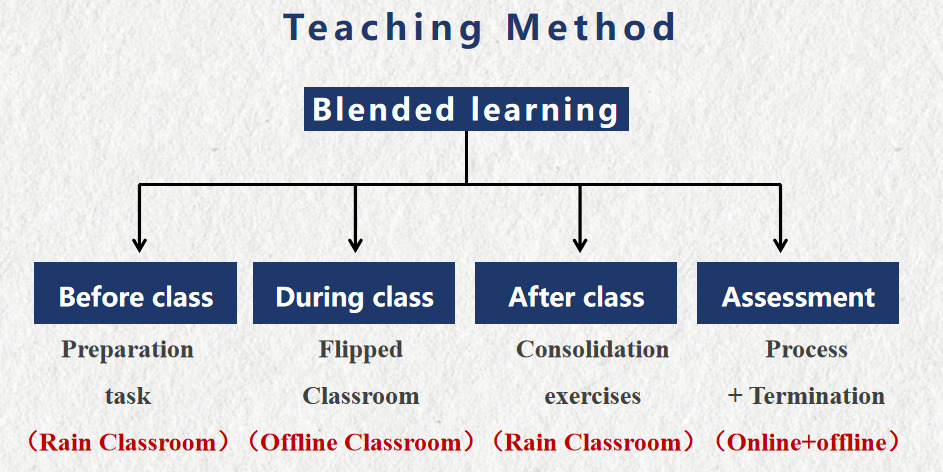
Figure 1. Blended Teaching Model
3.3. Teaching Content: Integrating Online and Offline Resources to Break the “Textbook-Only” Approach
In accordance with the course objectives, course resources are constructed to go beyond the limitations of the textbook by integrating high-quality online teaching resources with the course content (as shown in Figure 2). Three types of course resources are developed:
- Guidance Resources: These include the “Business English Talent Training Program,” “Basic English Course Syllabus,” and “Basic English Course Lesson Plans,” all based on the outcome-oriented educational philosophy.
- Content Resources: These encompass “Basic English” teaching courseware, micro-courses related to the teaching content, and supplementary resources.
- Generated Resources: These consist of teaching reflections, representative student assignments, student-created videos, and group presentations.
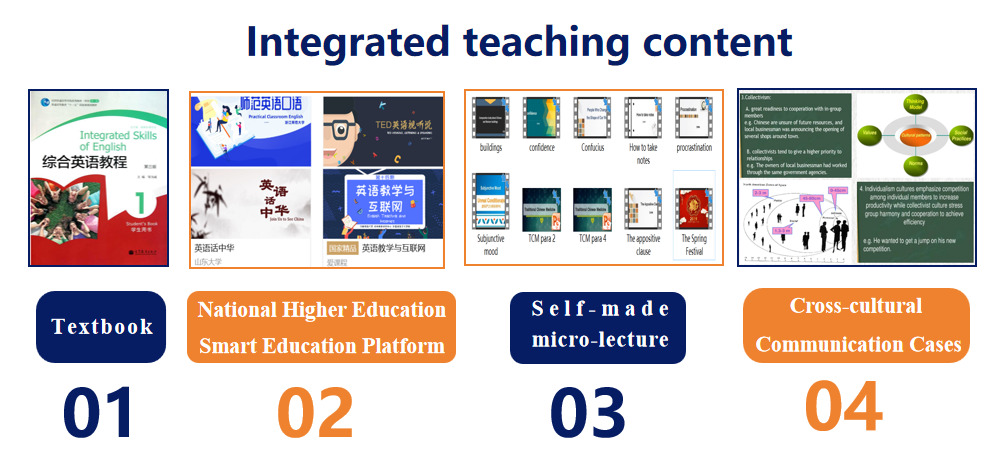
Figure 2. Integrating Teaching Resources
3.4. Teaching Activities: Comprehensive Classroom, Unity of Knowledge and Practice, Cultivating Higher-Order Abilities
Classroom teaching is implemented based on an outcome-oriented teaching model, creating a “comprehensive classroom” that employs various blended teaching modes (as shown in Figure 3). Traditional classrooms revolve around the teacher, classroom, and predetermined textbook, with a closed environment and fixed content, leading to almost unchanging teaching methods. In contrast, the “comprehensive classroom” adapts to course objectives and the actual situation of students, employing flexible teaching models and methods. Through diverse and multi-level classroom activities, it helps students enhance their abilities.
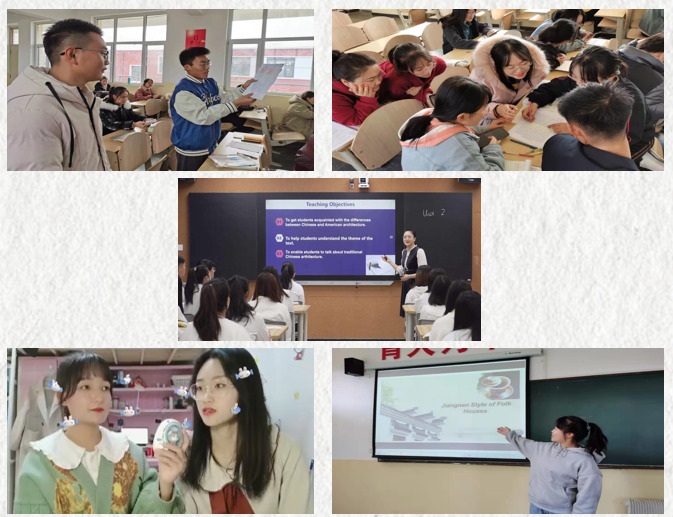
Figure 3. Striving to Create a “Comprehensive Classroom”
3.5. Teaching Evaluation: Implementing the “N+1+1” System to Emphasize the Process Assessment
A diversified assessment system is adopted, combining formative and summative evaluations to comprehensively assess the learning situation (as shown in Figure 4). The assessment method implements the “N+1+1” process assessment system, where “N” represents the number of assessments conducted throughout the teaching process, accounting for 40% of the total grade; the first “1” represents the final exam, accounting for 50% of the total grade; and the second “1” represents classroom notes, accounting for 10% of the total grade.
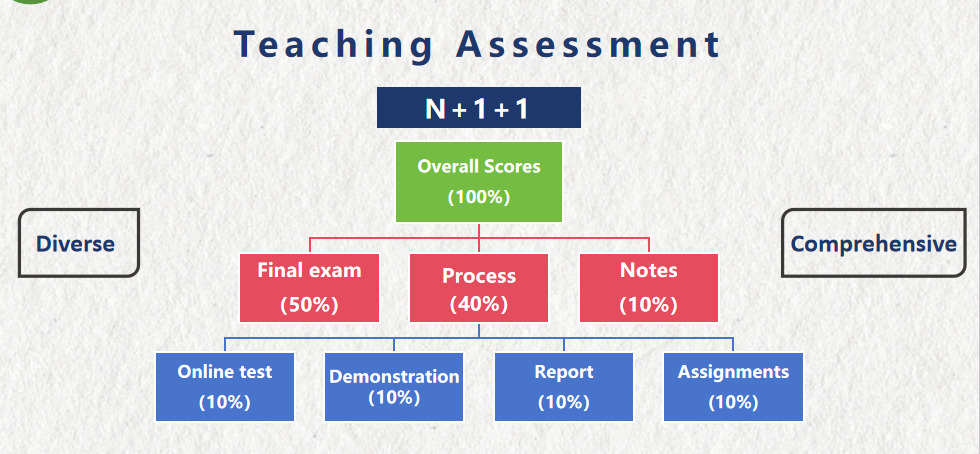
Figure 4. Diversified Assessment System
3.6. Curriculum Ideology and Politics: Refining Elements, Mapping, and Telling China’s Story
The English learning classroom is a crucial channel for moral education, intellectual development, and effective cultural dissemination. In the innovative practice of course teaching, the teacher, referencing Professor Wen Qiufang’s model [5], reorganizes curriculum ideology and politics into four ideological chains: content chain, management chain, evaluation chain, and teacher behavior chain.
- Content Chain: Teachers fully explore elements of moral education based on each unit theme, designing each lesson with an ideological and political component. By incorporating the latest political news and traditional cultural materials, they tell China’s story in English, embedding both explicit and implicit teaching objectives into the teaching plan (as shown in Figure 5).
- Management Chain: Teachers guide students in practicing ideological education through classroom management, including attendance, leave requests, homework submission, academic integrity, mutual assistance, and collective spirit.
- Evaluation Chain: Teachers design value-oriented test questions, making implicit ideological education explicit and forming measurable evaluation elements. This assesses not only students’ grasp of English language knowledge but also their development in worldview, life perspective, and values.
- Teacher Behavior Chain: Teachers strictly adhere to documents such as the “Ten Guidelines for Professional Behavior of College Teachers in the New Era,” leading by example and continually improving both internal cultivation and external image to serve as role models for students.
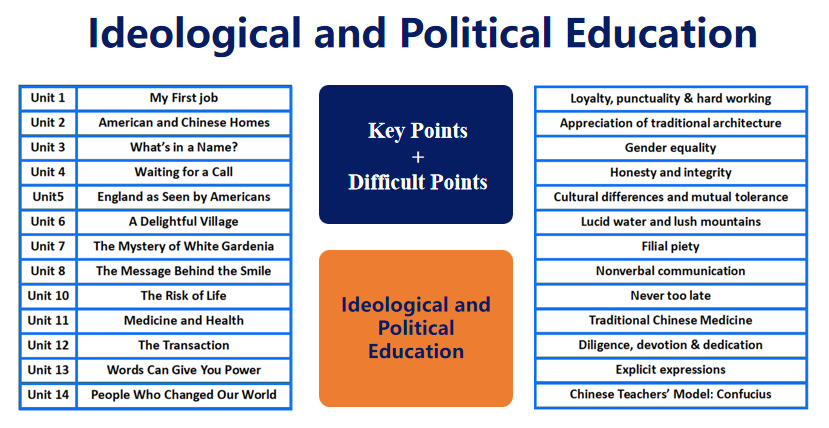
Figure 5. Deepening Teaching Content: Achieving “One Lesson, One Ideology” on the Basis of Explaining Key Points
4 Blended Teaching to Improve Effectiveness
In the context of new liberal arts education, the teaching team employs a blended teaching method that combines online and offline approaches. Utilizing high-quality online teaching resources, the “Basic English” course resources are restructured to be “student-centered,” leveraging various platforms to expand learning time and space and enhance student learning outcomes.
Since 2018, our institution has encouraged teachers to reform their teaching methods by incorporating both online and offline elements. Multiple interactive tools have been introduced, including ClassIn, Rain Classroom, Tencent Meeting, DingTalk Live, and Superstar Learning, to help teachers achieve a seamless “before-during-after class” teaching chain, breaking the constraints of time and space to meet teaching objectives and improve effectiveness. The specific process for the teaching team is as follows:
4.1. During the 2018-2019 Teaching Period
Team teachers experimented with using ClassIn to send pre-study tasks in advance. Students completed these tasks via mobile terminals, allowing them to be familiar with the classroom content beforehand. However, due to insufficient system data retention at that time, the formative learning data of students did not form a complete system.
4.2. Starting with the 2019 Cohort of Business English Students
Teachers used Rain Classroom to establish a “before-during-after class” learning chain. Specifically, before class, notifications and reminders were sent via the platform, along with pre-study materials or micro-lesson videos that explained key concepts and difficult points, accompanied by relevant exercises to assess students’ grasp of new knowledge. During class, methods such as flipped classroom, case analysis, and task-driven teaching were used to provide a realistic language environment, improving listening and speaking skills, and highlighting the “student-centered” teaching philosophy. After class, in addition to traditional homework, teachers assigned extension tasks through Rain Classroom to reinforce key points, and introduced diverse homework forms such as speeches, debates, video production, and group reports.
4.3. During the COVID-19 Pandemic in 2020
When universities nationwide postponed the start of the semester, following the Ministry of Education’s notice on delaying the spring semester of 2020, the teaching team adjusted the teaching format and content in a timely manner to ensure “classes are suspended but learning continues.” They used DingTalk Live for online teaching according to the “Basic English” course syllabus and the characteristics of online teaching. In addition to leveraging Rain Classroom’s advantages, DingTalk Live included activities like roll call, online quizzes, bullet comments, and discussions to engage students actively in class activities, effectively transforming teachers into “broadcasters” and addressing the distance issue in online teaching. After class, high-quality resources from China’s MOOCs were utilized to help students expand their knowledge, making learning time and location flexible.
DingTalk Live’s screen sharing and video recording features recreated the classroom environment, allowing students to clearly see the teaching materials used by the teacher. Students could review recorded videos to master the knowledge points thoroughly, ensuring good teaching effectiveness and forming a “before-during-after class” learning chain and a blended teaching model of “physical classroom + online teaching platforms (DingTalk Live + Rain Classroom) + student mobile terminals.”
5 Enhancing Teaching through Competitions and Experience Sharing
The course team actively explores innovative teaching models and engages in exchanges and learning through competitions to enhance teaching quality. In recent years, the team leader and members have participated in various projects within the university, such as course evaluations, teaching skills competitions, online course development, compilation of ideological and political case studies, and lecture observations. These activities foster exchanges with peers, sharing experiences and insights.
Additionally, the team has actively participated in teaching innovation activities, achieving significant accolades. They won the second prize in the provincial finals of the inaugural “Smart Cup” Smart Classroom Teaching Innovation Competition and were honored with the title of “Smart Teaching Expert.” Building on their previous efforts, the course team successfully applied for and was approved to undertake the provincial-level undergraduate education and teaching reform research and practice project, titled “Reform Practice of Blended Teaching Methods for ‘Basic English’ Based on ‘Internet+’“. In October 2021, during the collection and exchange activity of excellent ideological and political teaching cases for higher education (undergraduate) foreign language courses, organized by the National Network Training Center for College Teachers and China Foreign Language Publishing House, the teaching team won the first prize in the English major group. In June 2022, they secured the third prize in the national finals of the FLTRP “Teaching Star” competition and the second prize in the second Ningxia Higher Education Teacher Teaching Innovation Competition. In September 2022, the team won the grand prize in the 2022 Ideological and Political Teaching Design Competition for Higher Foreign Language Courses in the Central and Western Regions. In October 2023, they were awarded the first prize in the FLTRP National Ideological and Political Teaching Case Competition for College Foreign Language Courses. (Some award certificates are shown in Figure 6.) Based on their organization, summary, and reflection, team members have published several papers related to the course.
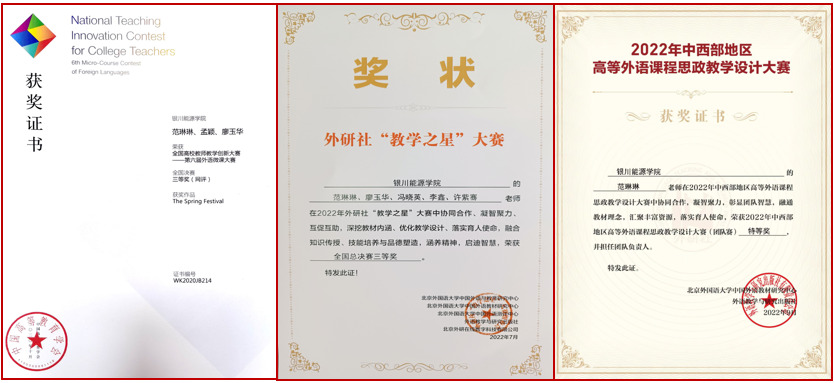
Figure 6. Some Award Certificates
6 Conclusion
General Secretary Xi Jinping’s important discourse on education [6] clarifies the development direction of education in the new era of socialism with Chinese characteristics. It provides fundamental guidelines and an action plan for accelerating educational modernization, building a strong educational system, and offering education that satisfies the people. Based on the construction of a first-class “Basic English” course, this paper analyzes the student situation, clarifies teaching objectives, integrates teaching resources, and employs modern teaching methods to achieve blended teaching and improve student learning outcomes. Furthermore, it deeply explores and incorporates ideological and political elements into foreign language teaching, seamlessly integrating them like salt in water, thereby fulfilling the fundamental task of fostering virtue through education.
Project Source
June 25, 2021, Ningxia Hui Autonomous Region Department of Education, Ning Education High Office [2021] No. 7
References
[1]. Wu, Y. (2021). Grasping the “new infrastructure” in teaching to cultivate high-quality foreign language talents. Frontiers in Foreign Language Education Research, (2), 3-6.
[2]. Wang, X. (2020). Professional development of university foreign language teachers under the new normal of higher education: Connotation and path. Shandong Foreign Language Teaching, (4), 11-18.
[3]. Lattuca, L. R., & Stark, J. S. (2009). Shaping the College Curriculum: Academic Plans in Context (2nd ed.). San Francisco, CA: Jossey-Bass Inc.
[4]. Zhong, Q. (2007). Curriculum Theory. Beijing: Educational Science Publishing House.
[5]. Wen, Q. (2021). The connotation and implementation framework of ideological and political education in university foreign language courses. Chinese Foreign Languages, (3), 47-51.
[6]. Compilation Group of Important Expositions on Education by General Secretary Xi Jinping. (2020). Important Expositions on Education by General Secretary Xi Jinping. Beijing: Higher Education Press.
Cite this article
Fan,L.;Luo,Y. (2024). Innovative Exploration of First-Class Curriculum Construction Path for Basic English. Advances in Social Behavior Research,8,41-46.
Data availability
The datasets used and/or analyzed during the current study will be available from the authors upon reasonable request.
Disclaimer/Publisher's Note
The statements, opinions and data contained in all publications are solely those of the individual author(s) and contributor(s) and not of EWA Publishing and/or the editor(s). EWA Publishing and/or the editor(s) disclaim responsibility for any injury to people or property resulting from any ideas, methods, instructions or products referred to in the content.
About volume
Journal:Advances in Social Behavior Research
© 2024 by the author(s). Licensee EWA Publishing, Oxford, UK. This article is an open access article distributed under the terms and
conditions of the Creative Commons Attribution (CC BY) license. Authors who
publish this series agree to the following terms:
1. Authors retain copyright and grant the series right of first publication with the work simultaneously licensed under a Creative Commons
Attribution License that allows others to share the work with an acknowledgment of the work's authorship and initial publication in this
series.
2. Authors are able to enter into separate, additional contractual arrangements for the non-exclusive distribution of the series's published
version of the work (e.g., post it to an institutional repository or publish it in a book), with an acknowledgment of its initial
publication in this series.
3. Authors are permitted and encouraged to post their work online (e.g., in institutional repositories or on their website) prior to and
during the submission process, as it can lead to productive exchanges, as well as earlier and greater citation of published work (See
Open access policy for details).
References
[1]. Wu, Y. (2021). Grasping the “new infrastructure” in teaching to cultivate high-quality foreign language talents. Frontiers in Foreign Language Education Research, (2), 3-6.
[2]. Wang, X. (2020). Professional development of university foreign language teachers under the new normal of higher education: Connotation and path. Shandong Foreign Language Teaching, (4), 11-18.
[3]. Lattuca, L. R., & Stark, J. S. (2009). Shaping the College Curriculum: Academic Plans in Context (2nd ed.). San Francisco, CA: Jossey-Bass Inc.
[4]. Zhong, Q. (2007). Curriculum Theory. Beijing: Educational Science Publishing House.
[5]. Wen, Q. (2021). The connotation and implementation framework of ideological and political education in university foreign language courses. Chinese Foreign Languages, (3), 47-51.
[6]. Compilation Group of Important Expositions on Education by General Secretary Xi Jinping. (2020). Important Expositions on Education by General Secretary Xi Jinping. Beijing: Higher Education Press.





